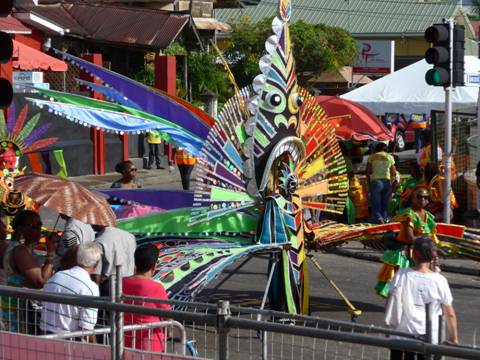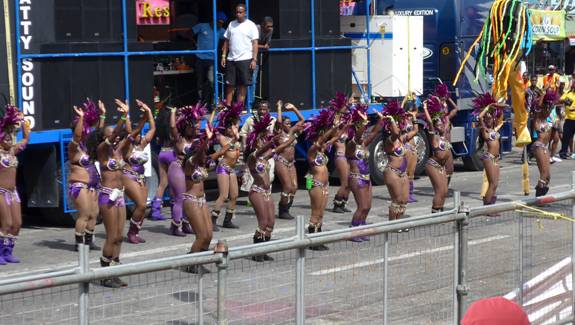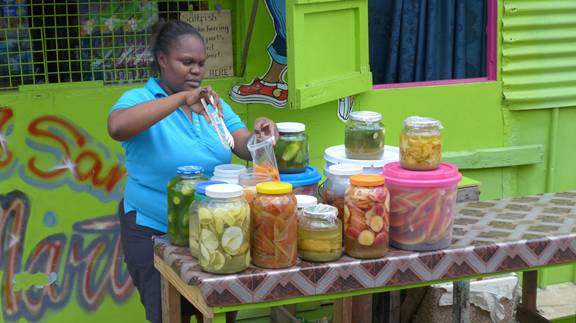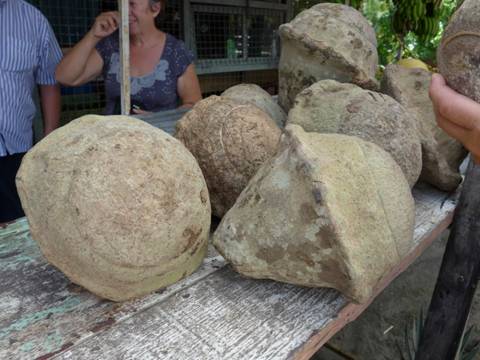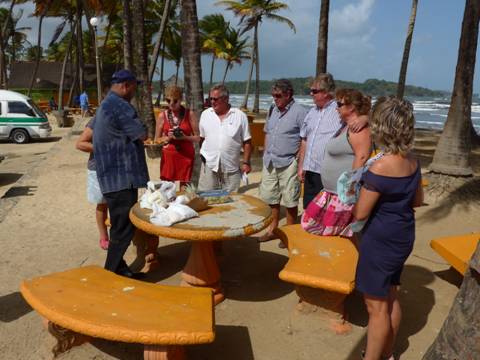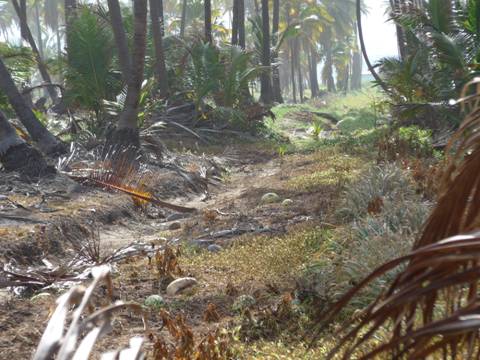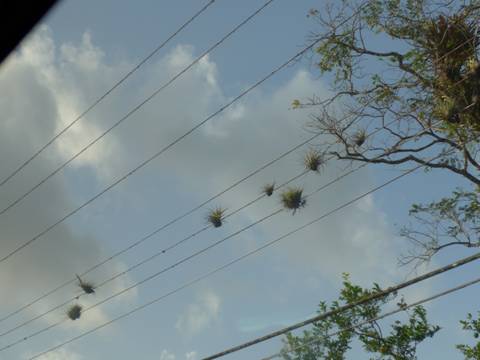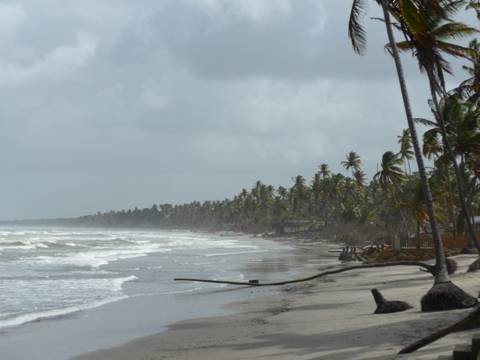Trinidad Carnival

|
The Trinidadians (who refer to themselves as “Trinies” like to claim the Carnival was invented here – something that a quick check online shows to be fanciful, but it certainly is a HUGE thing for them, so we’ll indulge their fantasy. They’ve certainly taken it to an extreme, absorbing a significant proportion of the country’s efforts from Christmas onwards. There are parties galore, parades, music events, bacchanalia – just too many to choose from. We decided to do just three, starting 10 days ago with a party in a hotel in nearby Port-of-Spain. It wasn’t cheap, but including all the food and drink you can consume plus almost continuous free live music, it was good value for money and great fun. We went with Tony & Anne, friends from Crete, and met a great French/Italian couple from Vancouver who certainly knew how to party! Next up was the “Pan Finals” – the culmination of months of preparations and heats for the medium and large categories of steel bands. As Lindsay said last time, I’ve never been a fan, but as this is where they were invented, I was happy to listen to the best of the best and see if my taste could be broadened. It wasn’t. The evening was extremely long – we left at 1 a.m. but the last band didn’t finish until after 4. Each band of up to 120 players had to assemble, shamble onto stage, then be marshalled into position with their seemingly innumerable steel pans. Whilst this was going on we were being blasted with Soca music. Claiming to be the “SOul of CAlypso”, it features a massive beat, endlessly repetitive lyrics and nothing else. Some of the songs were great fun, but one in particular we came to loath as it was also played endlessly in the Tuesday parades. (A note from Lindsay so we don’t sound too negative on this!) We were judging the evening by some musical criteria when we learned that it is really all about the show and the creation of an exuberant wall of sound. The allocation of points from the judges said it all – 40 each for presentation and performance and just 10 each for tone and rhythm. You couldn’t doubt the commitment of the players who put their all into each 8 minute performance. Our last event was Carnival Tuesday, the final parade of the “Mas” (masquerade) camps. Many of them were led by their Mas King or Queen, a hugely ornamental costume supported by a human plus trolley contraption, often filling half the street. Three “Kings”:
Each was accompanied by its own music truck – a full sized lorry stacked with loudspeakers and driven by a huge generator. These were LOUD – in a way we’ve never experienced before. Earplugs were vital, but apart from making it impossible to talk to each other, they were completely ineffective. You could feel the music through every part of your body – often making your entire stomach throb. To make matters worse almost all the trucks were playing the same “song”, endlessly repeated for hour after hour. I’m beginning to sound an old bore, but it was truly awful! Many locals give the whole thing a miss and take to the hills on the day as they too are unimpressed by it apparently and say it is aimed more at us tourists. Dancers backed by a sound truck:
On the other hand the costumes were entertaining. Many were so skimpy they were hardly there at all. The skimpiest were worn by the largest ladies – and they were pretty huge! We reckoned the large to normal ratio was about 20:1. Much of the dancing was pretty lewd as well – in fact the local papers have been up in arms for the last few days asking how this in any way represents Trini culture. We suffered a 2 hour break between groups at one stage as there was some sort of traffic jam a few miles “upstream”, so by the time we left at 3 pm (having left the marina at 5:45am), many of the bands had yet to come past where we were sitting. Ho hum, we were pretty deafened by then and glad to leave, feeling we had to experience it, but never again! An almost there costume:
Dancers of varying sizes:
By far the most entertaining and educational thing we have done since returning here was our all day “Taste of Trini” tour. It had been highly recommended by other yachties and we weren’t disappointed. The delightful, very well informed and incredibly energetic owner of the local taxi and tours outfit, Jesse James, took 10 if us all over the island tasting local foods as we went. The tally came to 87 different things including various exotic fruits, Indian influenced sweetmeats and of course, many examples of the highly spiced pies, breads and meats that represent the best of local fast food. At one roadside stall they were selling pickled fruits in large jars. They looked delicious and refreshing but were all incredibly spicy. It was a strange sensation to eat slices of papaya, mango and even apple (not a local fruit of course) that were challengingly hot, hot, hot!
At a dusty spot just off the main road, we joined the queue at a popular truck frying up fresh breakfast snacks. “Doubles” are particularly Trinidadian and consist of a bread called bara wrapped very loosely around curried chickpeas – delicious but impossible to eat without getting it everywhere. We tried root vegetables like cassava and dasheen, known here as “provisions” and also cow heel soup which didn’t go down so well. Yes, it had actual bits of cow heel which were pretty gelatinous although the soup itself was tasty. We had barbecued pig tails and shark burgers. We had slices of watermelon straight from the fields at a roadside stall but most amazing of all were the alien shapes like giant acorns that we were shown at another spot. These massive and weighty pods turned out to contain a variety of local brazil nut and we tasted both the nut and the white fleshy tail that it was attached to nestling inside with many others.
Tasting food on Manzanilla Beach: The two of us by the Atlantic coast:
Watermelons amongst the coconut trees: Epiphytes (bromeliads) growing on electricity wires!:
Orange “Immortal” trees decorated with weaver bird nests: More Atlantic coastline:
The other delight of the day was to see much more of the countryside and our route took us over to the wilder Atlantic coast of the island. We stopped on the lovely Manzanilla Beach for more food tasting and a quick paddle in the waves and then drove along the beautiful coast road between the swaying beach palms and the coconut plantations on the other side. These were underplanted with watermelons, protected from the Atlantic winds by wind-breaks made from coconut fronds. Later we passed large teak plantations and smaller areas of cocoa trees. We were assured that Trinidadian cocoa was the finest in the world of course! We also saw the remains of the sugar cane plantations that the government shut down some years ago, leaving the country to have to import sugar these days. Our almost 12 hour tour ended with a chocolate ice cream made locally. Trinidad certainly delivers some wonderful foodstuffs and we tried to imagine a similar tour in GB. How far would you have to go to find so many local goodies?
Now we are getting ready to set off early tomorrow to spend 2 days and nights at sea before anchoring back in one of our favourite spots from the route south at the islands of “Les Saintes” off Guadeloupe. We are keen to move on as we hanker to be on a breezy anchorage again and have the chance for a good walk once ashore, which is very difficult in this area. We have warmed to Trinidad meanwhile and the people are mostly delightful. Now we know how good the food can be too! We hope that we remember our boating skills once we hoist those sails as it has been a while. |


